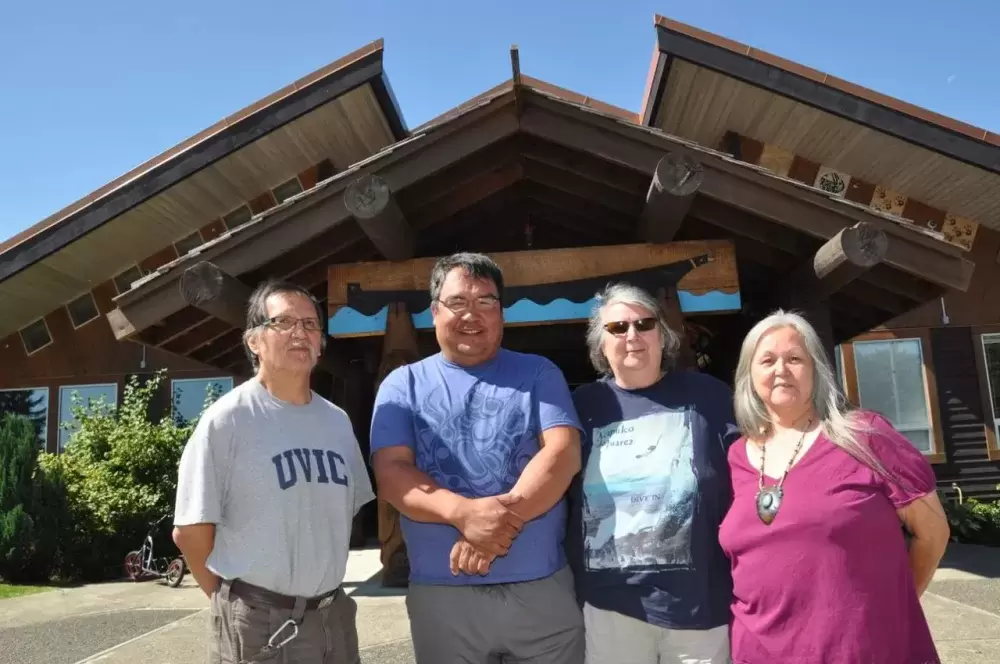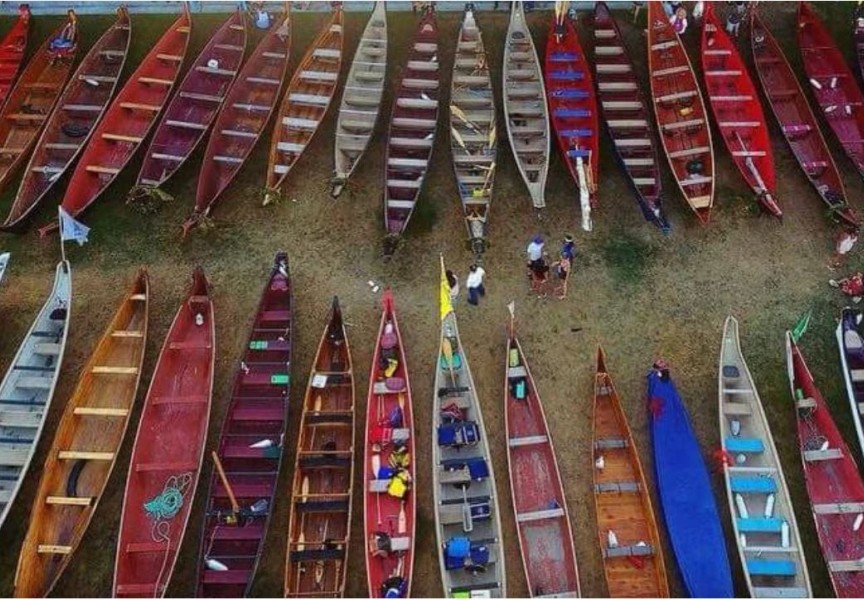Haahuupayak School was born to deal with the systemic problem of racism in the public school system.
“Our kids were labelled as soon as they walked through the door,” said Richard Watts, one of the five original board members of the Haahuupayak Society, which is gearing up to celebrate 40 years of delivering culturally-relevant education to the Nuu-chah-nulth children of the Alberni Valley.
“As soon as anything happened, they went down to Special classes.”
It’s not that the school district didn’t want Nuu-chah-nulth kids, said Anne Robinson, an original teacher of Ha-ho-payuk School, as it was originally named. The district received a set amount of money for each student who walked through their doors on the first day of school.
“They’d bring in the students through Sept. 30, and then let them go,” she explained. “They’d get the money for them, and they didn’t care.”
That was why there was some resistance from the school district when a few Nuu-chah-nulth community leaders proposed setting up an independent school using part of the old Alberni Indian Residential School complex on the Tseshaht reserve.
“The bottom line was they were worried about losing money. The tuition fee was the big thing,” Watts said.
The 40th anniversary celebration will take place at the school starting on Oct. 8 at 10 a.m. Ha-Shilth-Sa sat down with four of the people who have helped make Haahuupayak School “The Place of Learning” since those first brave steps were taken in 1976.
Watts said the first step was to create a society to receive the funding. It meant applying to both the federal and provincial governments.
Joining him on the society board was the now late Eileen Haggard, Hughie and George Watts, and with Denny Durocher, who also taught the alternative program.
“We are still a non-profit society, but now we now also have Independent School Certification,” Robinson said.
Hupacasath member April Thomas was another original teacher at Haahuupayak. But first she had to overcome the experience of passing through an uncaring school system.
“Going to school here in Port Alberni, I failed most of my classes except Math. Then when I went to college, I got straight A’s,” Thomas said. “I had my Early Childhood Education when I came in.”
One of the driving forces was the late Wahmeesh George Watts.
“It was great to have Porge, because he had university education and he knew that we could make it,” Richard Watts said.
“He had the vision and he had the drive,” Robinson said. “And he supported us younger ones.”
“He awakened us to the fact that we had self-esteem – so go for it. He pushed us,” Watts said. “Our people knew we could do it. We all knew damn well we were smart in school, but we were being treated like we weren’t. We had to push on and push out of that and make people believe.”
From the beginning, the Haahuupayak mandate was to provide education for all Nuu-chah-nulth children, Robinson explained.
“But there was an agreement between all the Ha’wiih that, because it was located on Tseshaht land – and especially the Barkley Sound tribes – they agreed that whatever we would teach would be Tseshaht.”
That meant all students would learn the Tseshaht dialect, songs, culture and protocols, and the parents of non-Tseshaht children would take responsibility for teaching them the words, songs and culture particular to their individual nation.
“The original school was in Peake Hall, the old girls’ dorm,” Robinson said. “We were in the cafeteria.”
“That first year, we had 36 kids in the morning and 45 in the afternoon. Those were the little kids, from three to five,” Thomas recalled.
“We had a van, and we went all over Port Alberni. Bob Thomas was the driver. We picked up all the kids in town and brought them to the reserve. Then we picked up all the kids from the reserve.”
That process was repeated, in reverse, at the end of every school day.
Long-time board member Martin Watts said while he didn’t have the actual numbers at hand, that early school population was largely non-Tseshaht, and currently, 60 per cent of Haahuupayak students live off-reserve.
Irma Bos was the first Nuu-chah-nulth language teacher. Through the early years, Katie Fraser and Caroline Little of Ahousaht First Nation came on board to teach, along with Kathy Robinson. All were fluent Nuu-chah-nulth speakers, Martin Watts noted.
“And Kathy still provides support to our staff,” he said. “She does not believe in the word ‘retirement’.”
Robinson said the phonetic alphabet that is currently used had not been created yet.
“We just sounded the words out,” she explained.
“We were lucky enough to be around parents and grandparents who only spoke our language,” Richard Watts added.
At the very beginning, teachers used off-the-rack coloring books and added Nuu-chah-nulth words. But by the end of that first year, the school was using original artwork by Nuu-chah-nulth artists.
“The songs we used then were mostly Tseshaht,” Robinson said. Mostly they were play songs, or familiar songs like the War Dance and the Victory Dance, she explained.
In the beginning, few could anticipate the effect of working in the old residential school on former students. At the time, most victims stayed silent. It would be years before the widespread abuses would become public knowledge, and before the debilitating effects of Post-Traumatic Stress Disorder were recognized, said Watts.
That was part of the multi-generational legacy that the Haahuupayak founders were determined to overcome.
“The way we were treated in public school carried over to us as parents,” Watts said. “We had to get past all that stuff and get through to our kids that they could succeed, and that they could believe in themselves.”
“That’s what the school was all about. To give them a good start and a good foundation,” Robinson said. “To give them a healthy environment and to encourage them to be themselves.”
“To make it a positive experience for them so they went home happy at the end of the day,” Thomas said.
That first year, Haahuupayak had Kindergarten, Playschool and Alternative classes for high school age students (later adults).
The second year, a secretary was hired and the fledgling school gradually added Grades 1-2, 3-4, 5-6 and 7, and all the requisite staff, including a principal, bus driver, Nuu-chah-nulth studies and language staff.
As it expanded, the school shifted over to Ross Hall, the boys’ dorm. Robinson said most of the desks, chairs and equipment had been left behind when the residential school shut down.
“And those classrooms were full,” she added.
Forty years on, Thomas said she has seen first-hand how Haahuupayak has provided that cultural foundation and confidence those early visionaries hoped to instill.
“When I’m taking language classes at university, when kids from Haahuupayak come in, they can talk,” she said.
For that reason, Thomas said all that effort on the part of so many people has been well worth it.
“This has been one of my biggest accomplishments, having been in at the beginning of this,” she said.
For now, the goal of the anniversary organizing committee is to create a celebration in keeping with the success of Haahuupayak School over the past 40 years.
“We will be approaching all Nuu-chah-nulth Nations for contributions to put together the banquet,” Robinson said. “We will also be approaching local merchants for contributions.”
The committee is just putting together a poster for the event, and they welcome all Nuu-chah-nulth to help with organizing the event.
“We will be meeting every Wednesday at 10 a.m. at the school through the end of August,” Robinson said. The meetings take place in the Grade 4 classroom.
For more information, contact Anne Robinson at 250-731-7641







